Spirograph
From Wikipedia, the free encyclopedia
| This article includes a list of references or external links, but its sources remain unclear because it lacks inline citations. Please improve this article by introducing more precise citations where appropriate. (April 2009) |
Spirograph is a geometric drawing toy that produces mathematical curves of the variety technically known as hypotrochoids and epitrochoids. The term has also been used to describe a variety of software applications that display similar curves, and applied to the class of curves that can be produced with the drawing equipment (so in this sense it may be regarded as a synonym of hypotrochoid). The name is a registered trademark of Hasbro, Inc.
Contents |
[edit] History
The Spirograph was invented by British engineer Denys Fisher who exhibited it in 1965 at the Nuremberg International Toy Fair. It was subsequently produced by his company. Distribution rights were acquired by Kenner, Inc., which introduced it to the United States' market in 1966.
[edit] Operation

A Spirograph consists of a set of plastic gears and other shapes such as rings, triangles, or straight bars. There are several sizes of gears and shapes, and all edges have teeth to engage any other piece. For instance, smaller gears fit inside the larger rings, but also can engage the outside of the rings in such a fashion that they rotate around the inside or along the outside edge of the rings.
To use it, a sheet of paper is placed on a heavy cardboard backing, and one of the plastic pieces is pinned to the paper and cardboard. Another plastic piece is placed so that its teeth engage with those of the pinned piece. For example, a ring may be pinned to the paper and a small gear placed inside the ring – the actual number of arrangements possible by combining different gears is very large. The point of a pen is placed in one of the holes in the moving piece. As the moving part is moved the pen traces out a curve.
The pen is used both to draw and provide locomotive force; some practice is required before Spirograph can be operated without disengaging the fixed and moving pieces. More intricate and unusual-shaped patterns may be made through the use of both hands, one to draw and one to guide the pieces. It is possible to move several pieces in relation to each other (say, the triangle around the ring, with a circle "climbing" from the ring onto the triangle), but this requires concentration or even additional assistance from other artists.
[edit] See also
- Epicycloid
- Guilloché
- Harmonograph
- Spirograph Nebula, a planetary nebula that displays delicate, spirograph-like filigree.
- Bruno Abakanowicz
[edit] External links
- Eric W. Weisstein, Spirograph at MathWorld.
- Spirograph Toy Collection - Collection with photos of many versions including UK and Australian issues.
- Software Spirograph in Javascript und AFLAX/Flash
- Spirograph source files in C#


